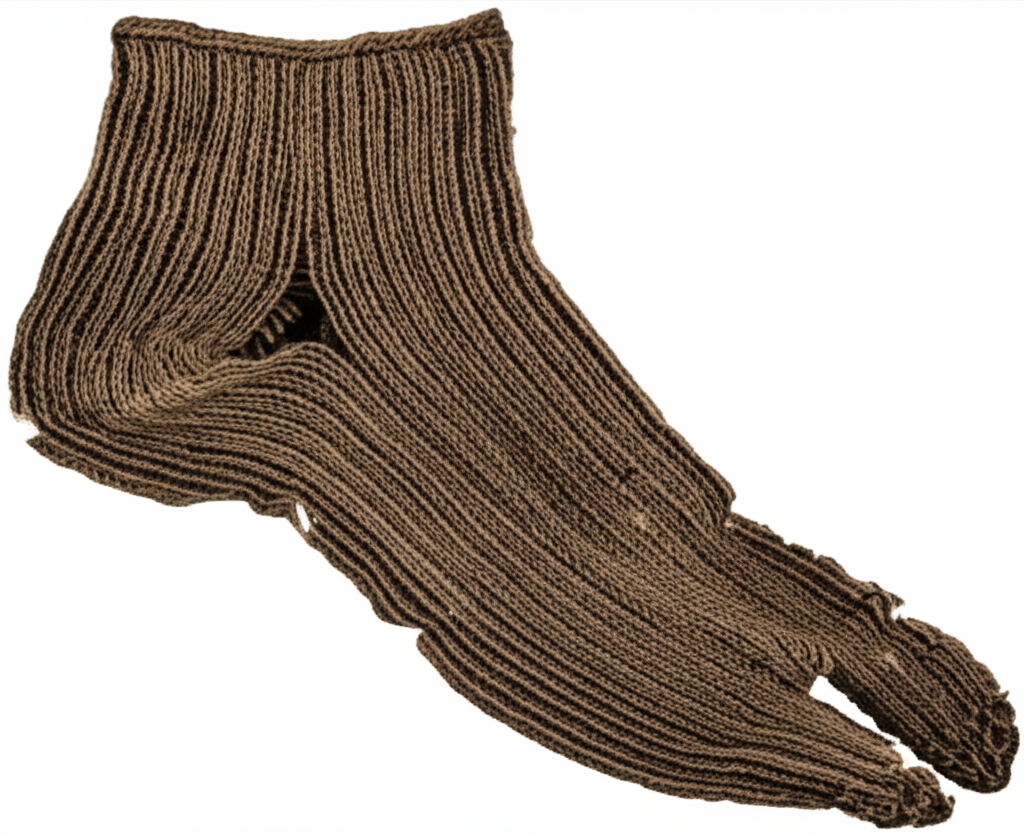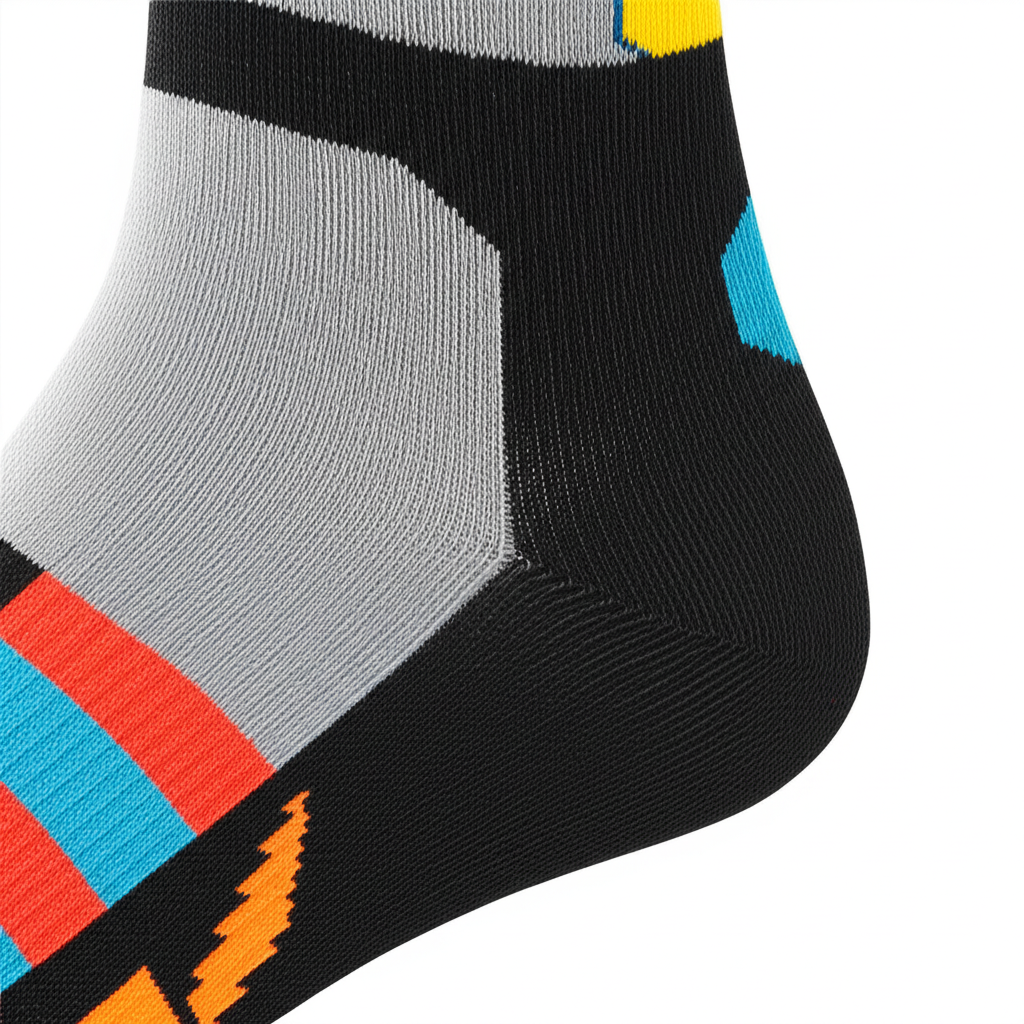Everyone wears socks. They’re an everyday essential, often overlooked until that mysterious moment when one disappears in the laundry. But how much do you truly know about this humble garment that covers our feet? Explore more about the fascinating history of everyday clothing items.
Socks have a surprisingly rich and long history. They have journeyed from being basic ancient foot wraps to becoming sophisticated fashion statements and crucial performance gear. This post will take you through their evolution. We’ll uncover their history, trace the advancements in technology and materials, share some surprising facts, and even offer tips on caring for them. Prepare to appreciate the unexpected depth and impact of socks throughout human history.

The Ancient Origins: Beyond Simple Wraps
Before the concept of fitted socks existed, ancient peoples used rudimentary foot coverings. These often involved wrapping feet in animal skins, basic woven fabrics, or tied-on leaves for protection and warmth. These early forms were functional but lacked the structure and form of later socks.
The development of knitting played a significant role in the creation of true socks. While the exact origins of knitting are debated, early techniques allowed for creating elastic, fitted garments. This was a crucial step away from simple wraps.
The oldest known examples of socks come from Egypt. These are the famous Coptic Egyptian socks, estimated to be around 1,700 years old (dating back to the 3rd to 5th centuries AD). Found at archaeological sites, particularly burial grounds, these socks are notable for their split-toe design, intended to be worn with sandals. Their preservation offers a rare glimpse into ancient textile production and daily life.
Early sock materials were natural fibers like wool, linen, or felted animal hair. Techniques were basic, often involving needle looping or early forms of knitting. These handmade methods were slow and labor-intensive, making socks relatively valuable items.
Socks Through the Ages: Status, Style, and Stitching
Medieval and Renaissance Socks: Symbol of Status
During the Medieval and Renaissance periods, foot coverings evolved significantly. What we now think of as socks were often integrated into “hosen,” which were close-fitting garments covering the legs and sometimes attaching to the doublet or undershirt.
The materials used in hosen and early separate stockings varied widely. Commoners wore wool or linen, while the wealthy adorned their legs with fine silk or even velvet. The quality of the fabric, the color, and elaborate patterns became strong indicators of social standing and wealth.
Sumptuary laws in many European countries regulated clothing based on social class. While often focused on outer garments, these laws could also restrict the use of certain luxurious materials or colors in items like stockings, reinforcing their role as status symbols.
The Dawn of Automation: Knitting Machines
A pivotal moment in sock history was the invention of the mechanical knitting machine. In 1589, English clergyman William Lee invented the stocking frame. This revolutionary machine could knit rows of fabric much faster than a person could by hand.
Lee’s invention initially faced resistance from traditional knitters and even Queen Elizabeth I, who reportedly feared it would put hand-knitters out of business. However, the technology gradually spread, eventually leading to mass production.
The stocking frame dramatically increased the speed and efficiency of sock production. This led to lower costs and made stockings more accessible to a wider population. The transition from entirely handmade stockings to machine-made ones fundamentally changed the textile industry and the availability of this garment.
Modern Marvels: Materials, Tech, and Function
Fibers and Fabrication: From Wool to High-Tech Synthetics
Modern socks benefit from a vast array of materials. Traditional fibers like cotton and wool remain popular for comfort and warmth. However, the advent of synthetic fibers revolutionized sock production. Materials like nylon, polyester, acrylic, and spandex offer incredible durability, elasticity, and moisture management properties.
Different materials provide specific benefits. Wool is excellent for warmth and moisture-wicking, while cotton is breathable and soft. Synthetics offer durability, stretch, and quick drying. Spandex (Lycra) is essential for stretch and recovery, ensuring socks stay up and fit well.
Here’s a look at common materials and their uses:
| Material | Properties | Common Use Cases |
|---|---|---|
| Cotton | Soft, breathable, absorbent | Everyday socks, casual wear |
| Wool | Warm, moisture-wicking, odor-resistant | Hiking socks, cold weather socks |
| Nylon | Durable, strong, elastic | Adds durability, stretch, and form retention |
| Polyester | Durable, quick-drying, wrinkle-resistant | Adds durability, moisture-wicking, and pattern vibrancy |
| Spandex | High elasticity, shape retention | Essential for stretch, comfort, and stay-up power |
Advancements go beyond just materials. Modern sock construction includes features like seamless toes, reinforced heels and toes, arch support bands, and targeted cushioning. Knitting technology allows for complex patterns, textures, and anatomical fits tailored for specific activities.
Performance socks are a major area of development. Athletic socks offer cushioning, ventilation, and arch support. Compression socks provide graduated pressure to improve circulation, often used for medical purposes, travel, or athletic recovery. Specialized socks exist for hiking, skiing, running, and even conditions like diabetes, offering seamless interiors, non-binding tops, and moisture control.
The Rise of Novelty and Fashion Socks
In recent decades, socks have moved beyond mere function to become significant fashion accessories. No longer hidden away, they are now often deliberately shown off.
This transformation was fueled by the introduction of vibrant colors, bold patterns, and quirky designs. Socks became a canvas for self-expression, allowing individuals to add a pop of personality to their outfit, even in formal settings.
The trend of ‘statement socks’ gained popularity, turning footwear into a conversation starter. Funky patterns, pop culture references, and artistic designs allowed people to showcase their interests and creativity.
Many brands and designers embraced this trend, dedicating collections solely to fashionable socks. Companies like Happy Socks popularized the idea of socks as playful, disposable fashion items. This marked a significant shift in how socks were perceived and marketed.

Quirky Facts and Hidden Details
The Mystery of the Missing Sock
It’s a universal phenomenon: one sock disappears from a pair, seemingly into thin air. The “sock loss” problem plagues households worldwide.
Humorous theories abound, from hungry washing machines devouring single socks to mischievous sock gnomes collecting them for their own tiny wardrobes. While these explanations are fun, the reality is usually simpler: socks get stuck in washing machine drums, fall behind furniture, or get mixed up in mismatched piles.
To combat sock loss, people employ various strategies. These include using mesh laundry bags for socks, clipping pairs together before washing, or dedicating specific sock baskets. Products like sock clips or sorting bins are designed specifically to keep pairs together through the wash cycle.
World Records and Unusual Uses
Socks feature in some interesting records. The largest sock ever knitted can be incredibly huge, often made for charity or promotional events. The most expensive socks are typically crafted from rare materials like vicuña wool or involve intricate designs and high-fashion branding.
Socks also have surprisingly diverse non-traditional uses. They are classic materials for creating simple sock puppets, a staple of childhood crafting. Old socks can be used for cleaning rags, polishing shoes, or even as makeshift insulation fillers for drafts.
Beyond practical uses, empty socks can become impromptu DIY projects like heating pads (filled with rice), stress balls, or protectors for delicate items during packing. While perhaps not steeped in deep cultural tradition, the humble sock has certainly found its way into various corners of everyday life and creativity.
Caring for Your Footwear Companions
Proper care can significantly extend the life and performance of your socks. Always check the care label, but general guidelines apply. Washing socks in lukewarm or cold water helps preserve colors and prevents shrinkage, especially for natural fibers like wool and cotton. Using a mild detergent is also recommended. Sorting socks by color and fabric type (separating delicates or athletic socks) can prevent damage and color bleeding.
When it comes to drying, air drying is the gentlest method. It helps maintain the elasticity and shape of socks, particularly those made with spandex or performance materials. If using a machine dryer, opt for a low heat setting. High heat can damage fibers, reduce elasticity, and cause shrinkage.
Storing socks neatly helps keep pairs together and makes them easy to find. Folding or rolling socks into pairs are common methods. Using sock drawer organizers or dividers can keep your collection tidy and prevent the dreaded “mystery of the missing sock” before it even starts.
Minor damage, like small holes or loose threads, can often be repaired. Learning basic darning techniques can save favorite pairs and reduce waste. Addressing issues early prevents them from becoming larger, irreparable problems.
Conclusion
From ancient wraps and status symbols to high-tech performance wear and bold fashion statements, socks have a much richer and more varied history than most people realize. This everyday item has evolved alongside technology, fashion trends, and our understanding of comfort and function.
Socks are far more than simple foot coverings. They reflect advancements in textile production, played a role in social stratification, and now contribute to both personal style and athletic performance.
Take a moment to appreciate the design, the history, and the technology woven into the fabric of this essential garment. The next time you pull on a pair, remember the long and fascinating journey of the humble sock.
FAQ
Q: What are the oldest socks ever found?
A: The oldest known socks are the Coptic Egyptian socks, dating back to the 3rd to 5th centuries AD. They were made using needle looping and had a split-toe design.
Q: How did the invention of the knitting machine change socks?
A: William Lee’s stocking frame, invented in 1589, allowed socks to be produced much faster and more cheaply than by hand. This made them more accessible to average people, changing their status from a luxury item to a common garment.
Q: What’s the difference between cotton and wool socks?
A: Cotton is soft, breathable, and absorbent, good for casual wear. Wool is warmer, more moisture-wicking, and odor-resistant, ideal for colder conditions and hiking.
Q: Why do some socks have specific features like arch support or cushioning?
A: Modern performance socks are designed for specific activities or needs. Features like arch support, cushioning, and ventilation are engineered to improve comfort, prevent blisters, manage moisture, and enhance performance during sports or for medical reasons like aiding circulation.
Q: How can I stop losing socks in the laundry?
A: Common tips include using a mesh laundry bag for socks, clipping pairs together before washing, or dedicating specific containers or organizers for socks throughout the laundry process.

